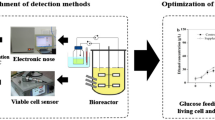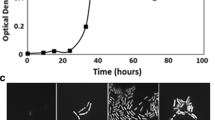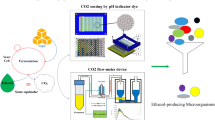Abstract
A microbial fuel-cell type activity sensor integrated into 500 mL and 3.2 L bioreactors was employed for ampero- (μA) and potentiometric (mV) measurements. The aim was to follow the microbial activity during ethanol production by Saccharomyces cerevisiae and to detect the end of carbohydrate consumption. Three different sensor setups were tested to record electrochemical signals produced by the metabolism of glucose and fructose (1:1) online. In a first setup, a reference electrode was used to record the potentiometric values, which rose from 0.26 to 0.5 V in about 10 h during the growth phase. In a second setup, a combination of ampero- and pseudo-potentiometric measurements delivered a maximum voltage of 35 mV. In this arrangement, the pseudo-potentiometric signal changed in a manner that was directly proportional to the amperometric signals, which reached a maximum value of 32 μA. In a third type of arrangement, a reference electrode was added to the anodic bioreactor compartment to carry out ampero- and potentiometric measurements; this is made possible by the high internal resistance of the cultivation. In this case, the reference potential rose to 0.44 V while the current maximum recorded by the working electrodes reached 27 μA. Reference and pseudo-reference electrodes were in all cases K3Fe(CN)6/carbon. Electrodes were made of 9 cm2 woven graphite. To compare the electrochemical signals with established values, the metabolism was also monitored for optical density (at 600 nm) indicating biomass production. For fructose and glucose conversion, HPLC with an Aminex column and RI detector was used, and ethanol production was analyzed by GC with methanol as internal standard. The combination of amperometric and potentiometric recordings was found to be an ideal setup and was successfully used in reproducible cultivations.






Similar content being viewed by others
References
Amerine MA, Thoukis G (1958) The glucose–fructose ratio of California grapes. Vitis 1:224–229
Barnett JA (2003) A history of research on yeasts 5: the fermentation pathway. Yeast 20:509–543. doi:10.1002/yea.986
Barton SC, Gallaway J, Atanassov P (2004) Enzymatic biofuel cells for implantable and microscale devices. Chem Rev 104:4867–4886. doi:10.1021/cr020719k
Benetto HP, Stirling JL, Tanaka K, Vega CA (1983) Anodic reactions in microbial fuel-cells. Biotechnol Bioeng 25:559–568. doi:10.1002/bit.260250219
Berthels NJ, Cordero Otero RR, Bauer FF, Thevelein JM, Pretorius IS (2004) Discrepancy in glucose and fructose utilisation during fermentation by Saccharomyces cerevisiae wine yeast strains. FEMS Yeast Res 4:683–689. doi:10.1016/j.femsyr.2004.02.005
Bond DR, Lovley DR (2003) Electricity production by Geobacter sulfurreducens attached to electrodes. Appl Environ Microbiol 69:1548–1555. doi:10.1128/AEM.69.3.1548-1555.2003
Bullen RA, Arnot TC, Lakeman JB, Walsh FC (2006) Biofuel cells and their development. Biosens Bioelectron 21:2015–2045
He Z, Angenent LT (2006) Application of bacterial biocathodes in microbial fuel cells. Electroanalysis 18:2009–2015. doi:10.1002/elan.200603628
Heilmann J, Logan BE (2006) Production of electricity from proteins using a microbial fuel cell. Water Environ Res 78:531–537. doi:10.2175/106143005X73046
Holleman-Wiberg (1985) Lehrbuch der anorganischen chemie 91-100. Walter de Gruyter, Berlin, pp 1142–1143
Heller A (2006) Potentially implantable miniature batteries. Anal Bioanal Chem 385:469–473. doi:10.1007/s00216-006-0326-4
Holme DJ, Peck H (1998) Analytical biochemistry, 3rd edn. Prentice Hall, Harlow, pp 169
Holtmann D, Schrader J, Sell D (2006) Quantitative comparison of the signals of an electrochemical bioactivity sensor during the cultivation of different microorganisms. Biotechnol Lett 28:889–896. doi:10.1007/s10529-006-9021-y
Kang KH, Jang JK, Phan TH, Moon H, Chang IS, Kim BH (2003) A microbial fuel cell with improved cathode reaction as a low biochemical oxygen demand sensor. Biotechnol Lett 25:1357–1361. doi:10.1023/A:1024984521699
Kim FH, Chang IS, Gil GC, Park HS, Kim HJ (2003) Novel BOD (biological oxygen demand) sensor using mediator-less microbial fuel cell. Biotechnol Lett 25:541–545. doi:10.1023/A:1022891231369
Logan BE (2005) Simultaneous wastewater treatment and biological electricity generation. Water Sci Technol 52:31–37
Miyabayashi A, Danielsson B, Mattiasson B (1987) A dual fuel-cell for flow-through quantification of microorganisms. Ann N Y Acad Sci 501:555–557. doi:10.1111/j.1749-6632.1987.tb45777.x
Niessen J, Schröder U, Harnisch F, Scholz F (2005) Gaining electricity from in situ oxidation of hydrogen produced by fermentative cellulose degradation. Lett Appl Microbiol 41:286–290. doi:10.1111/j.1472-765X.2005.01742.x
Oh SE, Logan BE (2005) Hydrogen and electricity production from a food processing wastewater using fermentation and microbial fuel cell technologies. Water Res 39:4673–4682. doi:10.1016/j.watres.2005.09.019
Rabaey K, Clauwaert P, Aelterman P, Verstraete W (2005) Tubular microbial fuel cells for efficient electricity generation. Environ Sci Technol 39:8077–8082. doi:10.1021/es050986i
Rabaey K, Lissens G, Siciliano SD, Verstraete W (2003) A microbial fuel cell capable of converting glucose to electricity at high rate and efficiency. Biotechnol Lett 25:1531–1535. doi:10.1023/A:1025484009367
Ramon-Protugal F, Pingaud H, Strehaiano P (2004) Metabolic transition step from ethanol consumption to sugar/ethanol. Biotechnol Lett 26:1671–1674. doi:10.1007/s10529-004-3520-5
Stickler M, Rhein T (2000) Ullmann’s encyclopedia of industrial chemistry (online edition). Wiley-VCH, Weinheim
Szucs A, Hitchens GD, JO’M Bockris (1989) On the adsorption of glucose-oxidase at a gold electrode. J Electrochem Soc 136:3748–3755. doi:10.1149/1.2096541
Zhang X-C, Halme A (1995) Modeling of a microbial fuel-cell process. Biotechnol Lett 17:809–814. doi:10.1007/BF00129009
Zhao F, Harnisch F, Schröder U, Scholz F, Bogdanoff P, Herrmann I (2006) Challenges and constraints of using oxygen cathodes in microbial fuel cells. Environ Sci Technol 40:5193–5199. doi:10.1021/es060332p
Author information
Authors and Affiliations
Corresponding author
Rights and permissions
About this article
Cite this article
Favre, MF., Carrard, D., Ducommun, R. et al. Online monitoring of yeast cultivation using a fuel-cell-type activity sensor. J Ind Microbiol Biotechnol 36, 1307–1314 (2009). https://doi.org/10.1007/s10295-009-0614-z
Received:
Accepted:
Published:
Issue Date:
DOI: https://doi.org/10.1007/s10295-009-0614-z




